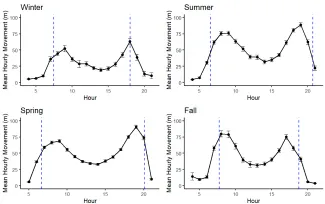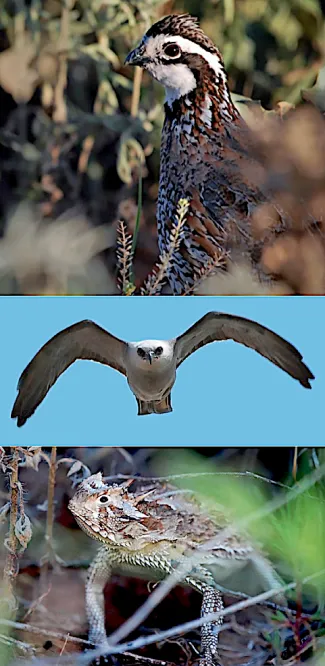
Figure 1. Mean hourly movement by season from GPS locations of northern bobwhite at Beaver River, Cross Timbers, Packsaddle, and Sandy Sanders WMAs combined during 2019–2021. Each point represents an hourly interval of movement and each point is placed at the beginning of the interval. The bars on each data point represent standard error for that mean. The dashed blue lines indicate mean sunrise and sunset times for each respective season.
* * *
Quail Ecology and Management Project Report for June 2021
Upland Update: Data Reveal Daily Quail Movement by Seasons
Provided by Oklahoma Cooperative Fish and Wildlife Research Unit, Oklahoma State University
The field work has ended for the quail component of the project, and the graduate students are analyzing data and writing their theses and dissertations. For the invertebrate and seed components, researchers will continue collecting data through spring.
Using quail location data collected by GPS transmitters, Landon Neumann examined 24-hour and seasonal rhythms in quail movement activity. The results showed that bobwhites exhibited two movement peaks during the diurnal period, one from 9 a.m. to 10 a.m. and the other from 5 p.m. to 10 p.m., dependent on season (Figure 1).
Data also show that quail moved the least during winter (Figure 1). The resulting paper has been submitted to Ecosphere for publication and is currently in peer review
INVERTEBRATE, RAPTOR STUDIES: In the invertebrate work, researchers collected 54 pitfall trap samples from within the burn treatment areas that were sampled for seeds in January.
Researchers also conducted 26 raptor surveys and recorded a total of 29 raptor sightings. Observed most frequently were Mississippi kites (18 sightings), followed by Swainson’s hawks (six), and red-tailed hawks (five). All Mississippi kites were observed in areas that were not burned for more than two growing seasons, and they were frequently observed at perching sites close to the access road.
Field work was cut short by persistent rain at the end of June, but the first half of the month offered several nice photo opportunities of some wildlife at Packsaddle Wildlife Management Area (see below).
* * *
(This project is funded in part by the Oklahoma Department of Wildlife Conservation, Federal Aid Project F18AF001-10: Quail Ecology and Management II.)
